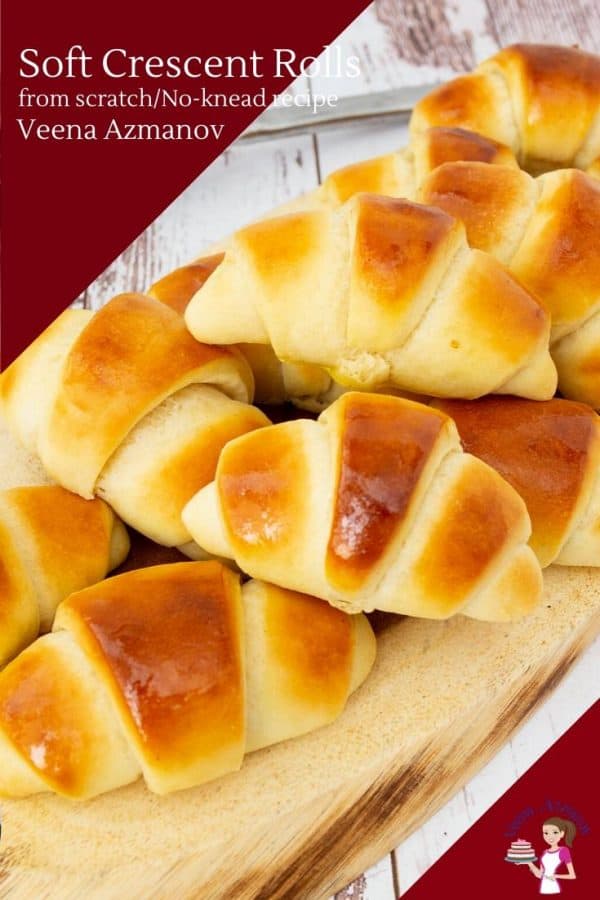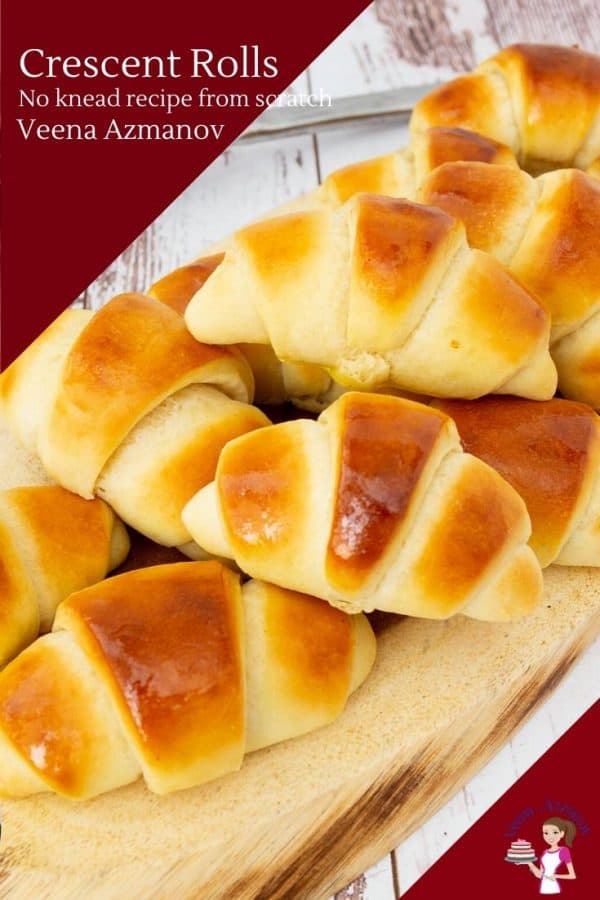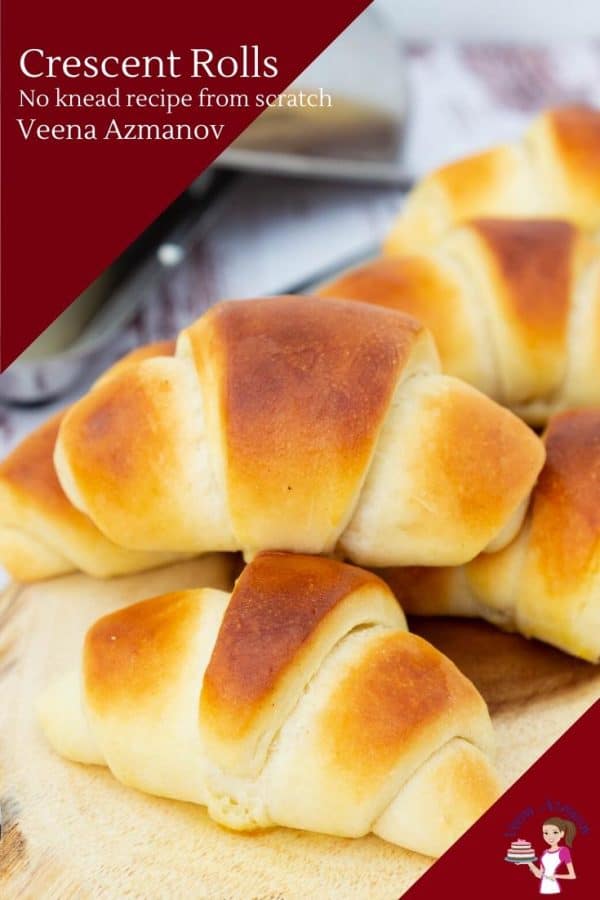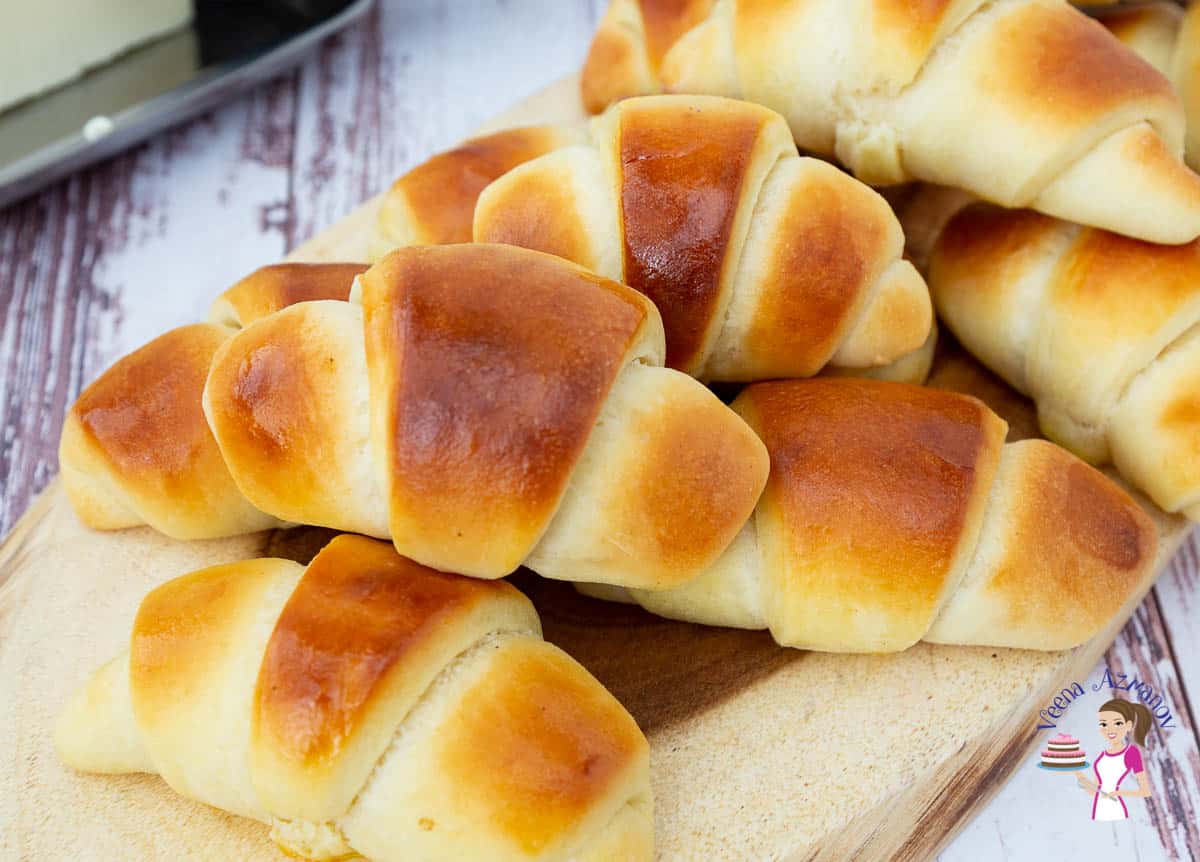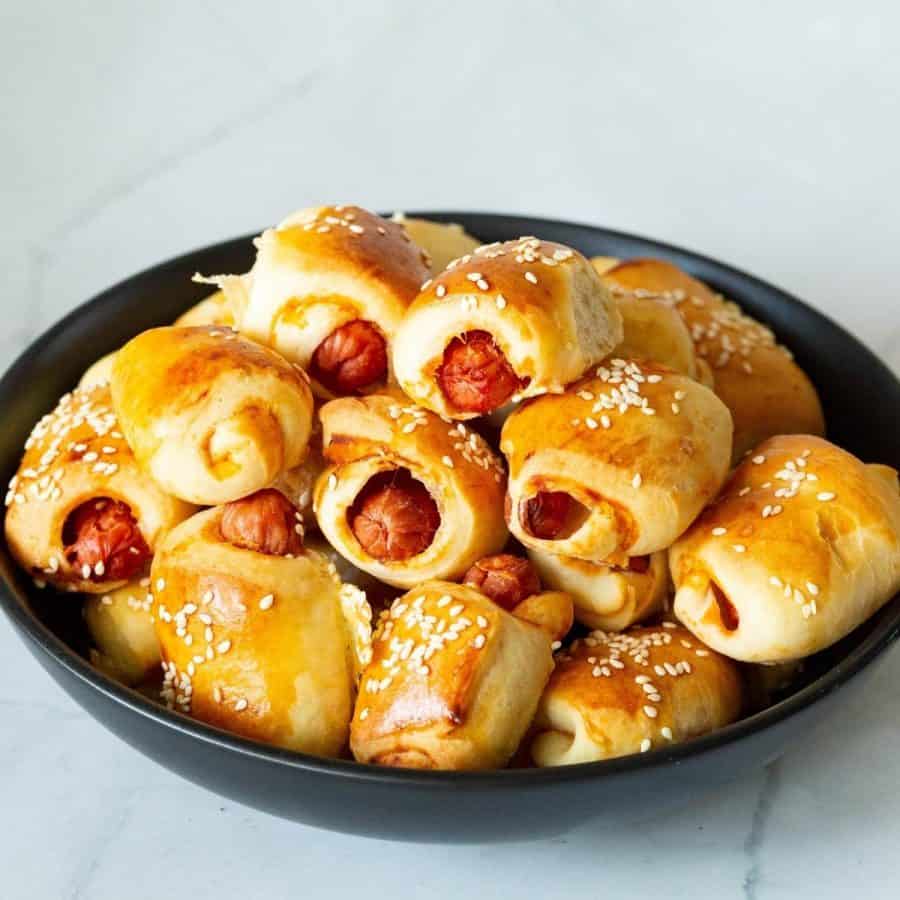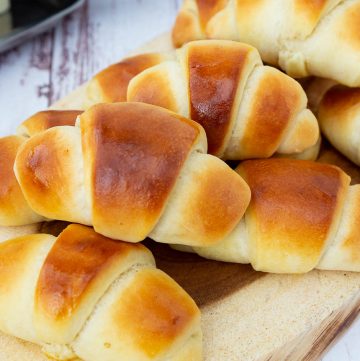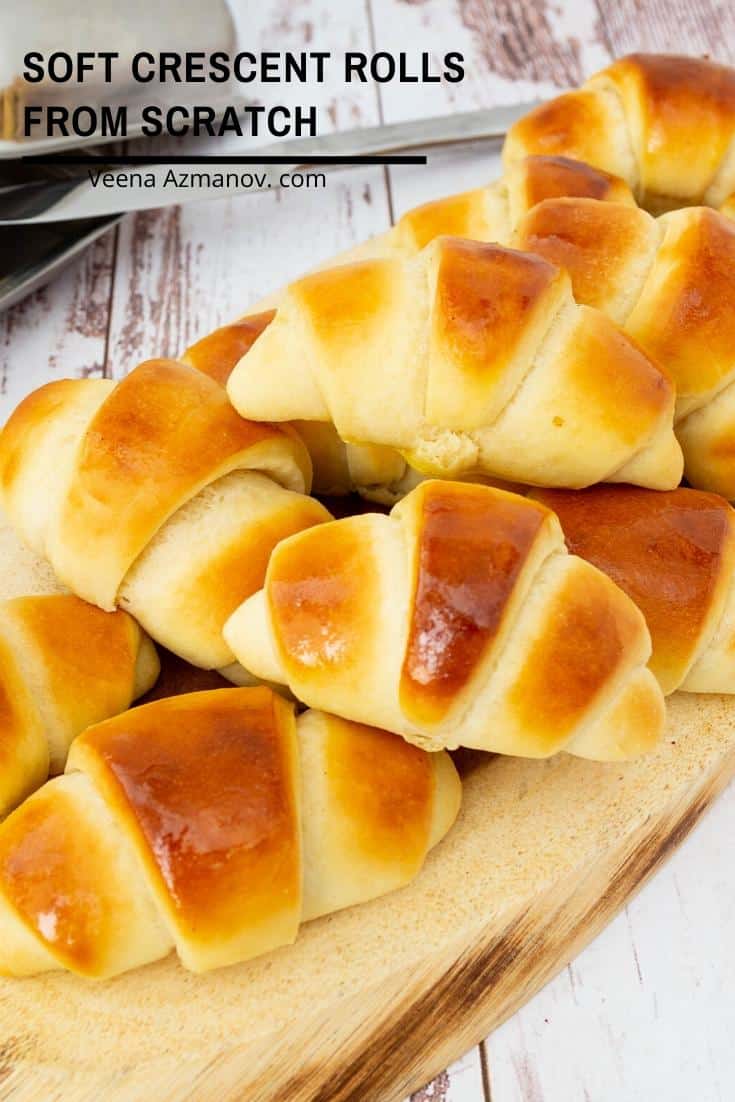Crescents, often referred to as crescent rolls, are delightful pastries characterized by their distinctive crescent shape. Made from a rich, buttery dough that is rolled into a circle, cut into wedges, and then rolled up from the wide end to the point, these pastries bake into flaky, golden-brown treats with a soft, airy interior. They can be enjoyed plain or filled with sweet or savory ingredients, making them versatile for any occasion. Crescents can be enjoyed as a breakfast item, a side dish, or even a dessert. They pair well with various fillings and toppings, from chocolate and jam to cheese and herbs. Despite their impressive appearance, crescents are relatively simple to make. Even novice bakers can achieve delicious results with straightforward steps and common ingredients. The combination of a buttery, flaky exterior and a tender, airy interior makes crescents a universally appealing treat. The rich flavor and satisfying texture are hard to resist. Crescents have a rich history and are associated with various culinary traditions around the world. Their shape is often linked to the Islamic crescent moon, adding a touch of historical and cultural charm to their allure. The basic dough serves as a blank canvas for creativity. Bakers can experiment with different fillings, shapes, and sizes, making each batch unique and tailored to personal tastes.
Why is this the best recipe?
Rich, Buttery Flavor: The generous use of butter in both the dough and the brushing process ensures that each crescent is packed with a rich, buttery flavor that is both indulgent and satisfying. Perfect Texture: The combination of yeast and a well-kneaded dough creates a light, airy, and fluffy texture inside, while the exterior bakes to a beautiful golden brown with a slight crispiness. Easy to Follow: The recipe is straightforward, with clear instructions that make it accessible even for novice bakers. The steps are logical and easy to follow, ensuring consistent results every time. Versatile and Customizable: This recipe serves as an excellent base for various customizations. You can add fillings like chocolate, jam, or cheese before rolling the wedges, or sprinkle toppings like sesame seeds or herbs for added flavor and visual appeal.
Ingredients and substitutes
All-Purpose Flour: Provides structure and body to the dough. The gluten formed during kneading helps give the crescents their chewy texture. Bread flour (for chewier texture), whole wheat flour (for a denser, more nutritious crescent; use 50-50 with all-purpose to maintain some lightness). Active Dry Yeast: Leavens the dough, making it rise and become light and airy. Instant yeast (use the same amount, and it doesn’t need to be activated in warm milk). Granulated Sugar : Adds sweetness, feeds the yeast, and contributes to the browning of the crescents. Honey or maple syrup (adjust liquid content accordingly), brown sugar (for a slightly different flavor). Salt: Enhances flavor and controls yeast fermentation. Sea salt or kosher salt (use slightly more due to larger grain size). Warm Milk (about 110°F/45°C): Activates the yeast, adds moisture, and enriches the dough. Warm water (less rich flavor), non-dairy milk (almond, soy, or oat milk). Large Eggs : Adds richness, structure, and helps with leavening. Flax eggs (1 tablespoon ground flaxseed + 3 tablespoons water per egg), applesauce (¼ cup per egg, for a slightly different texture). Unsalted Butter: Adds flavor, tenderness, and moisture to the dough. Margarine, coconut oil (for a different flavor), or vegan butter.
Step-by-step: Soft Fluffy Crescent Rolls
Activate the Yeast:In a small bowl, dissolve the sugar in the warm milk. Sprinkle the yeast over the milk and let it sit for about 5-10 minutes until it becomes frothy. Prepare the Dough: Combine the flour and salt in a large mixing bowl. Pour in the activated yeast mixture, eggs, and melted butter. Mix until a soft dough forms. Rise: Place the dough in a greased bowl, cover with a damp cloth, and let it rise in a warm place for about 1-2 hours or until it has doubled in size. Shape the Crescents: Punch down the risen dough and divide it into two equal parts. Roll each part into a circle about ¼ inch thick. Brush the entire surface of the dough with melted butter. Cut and Roll: Using a pizza cutter or sharp knife, cut the circle into 8-12 wedges (like slicing a pizza). Starting from the wide end, roll each wedge up towards the point to form a crescent shape. Place the crescents on a baking sheet lined with parchment paper, leaving some space between each one. Second Rise: Cover the baking sheet with a damp cloth and let the crescents rise again for about 30-45 minutes until they are puffy. Bake: Preheat your oven to 375°F (190°C). Brush the tops of the crescents with more melted butter. Bake for 15-20 minutes, or until the crescents are golden brown. Cool and Serve: Remove from the oven and let the crescents cool on a wire rack. Enjoy your buttery crescents warm or at room temperature.
Tips for Success
Proper Yeast Activation: Ensure your yeast is fresh and active. Check the expiration date on the packet. Use warm milk (about 110°F/45°C). Too hot, and it can kill the yeast; too cold, and the yeast won’t activate properly. Correct Dough Consistency: The dough should be soft and slightly sticky but not overly wet. If it’s too sticky, add a little more flour, one tablespoon at a time. Knead the dough until it’s smooth and elastic. This usually takes about 5-7 minutes by hand or 3-5 minutes in a stand mixer. Proper Rising: Allow the dough to rise in a warm, draft-free environment. If your kitchen is cold, you can place the bowl in an oven with just the light on, or use the proof setting if your oven has one. Ensure the dough doubles in size during the first rise. This might take longer in cooler environments. Shaping the Crescents: Roll the dough out evenly to ensure uniform baking. Use a ruler or a round cake pan as a guide for a perfect circle. When cutting the dough into wedges, use a sharp knife or pizza cutter for clean cuts. Rolling Technique: Start rolling from the wide end of the wedge to the point, keeping the roll tight but not overly tight. This helps create the crescent shape and ensures even baking. Tuck the point under the roll slightly to prevent it from unrolling during baking. Second Rise: Don’t skip the second rise. This step is crucial for achieving light, fluffy crescents. Cover the shaped crescents with a damp cloth or plastic wrap to prevent them from drying out during the second rise. Baking: Preheat your oven to ensure it’s at the correct temperature when you place the crescents inside. Bake until the crescents are golden brown. Oven temperatures can vary, so keep an eye on them and adjust the baking time as needed. Brush with Butter: Brush the crescents with melted butter before and after baking for an extra rich and buttery flavor. Optionally, sprinkle with coarse sugar or sea salt before baking for added texture and flavor. Cooling: Allow the crescents to cool on a wire rack after baking to prevent the bottoms from becoming soggy. Storage: Store any leftovers in an airtight container at room temperature for up to two days, or freeze for longer storage. Reheat gently in the oven to refresh their texture.
Cinnamon Crescent RollsVanilla Crescents Recipe That Will Blow Your Mind!Soft Pumpkin Crescent RollsPerfectly Flaky Almond Crescent Cookies (GF)Impress Your Guests with a Giant Cinnamon Roll Cake
Frequently asked questions
Did you LIKE this recipe? Save it for later. You can find my recipes on Pinterest. Follow me on Facebook, Twitter, and Instagram.Subscribe, and I’ll send you new recipes right to your inbox. Thank you for sharing - Save for later
